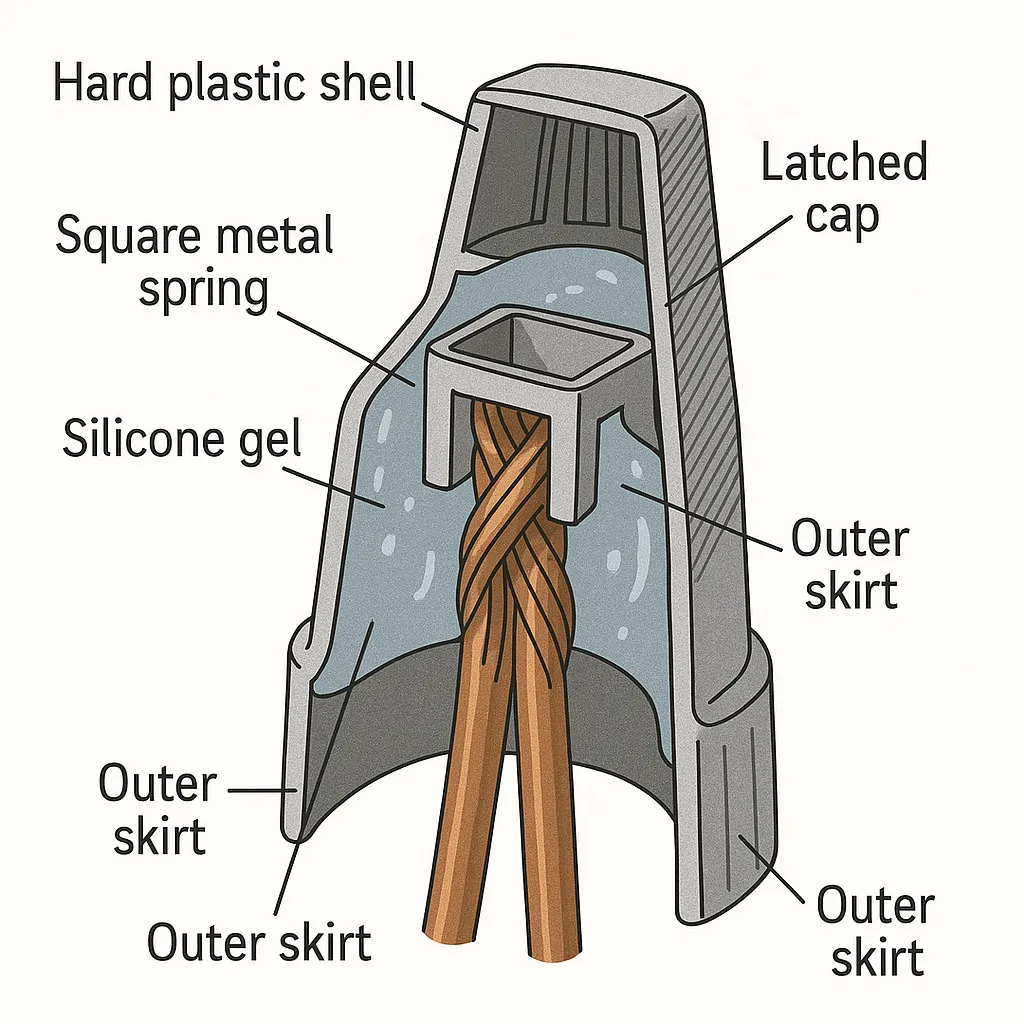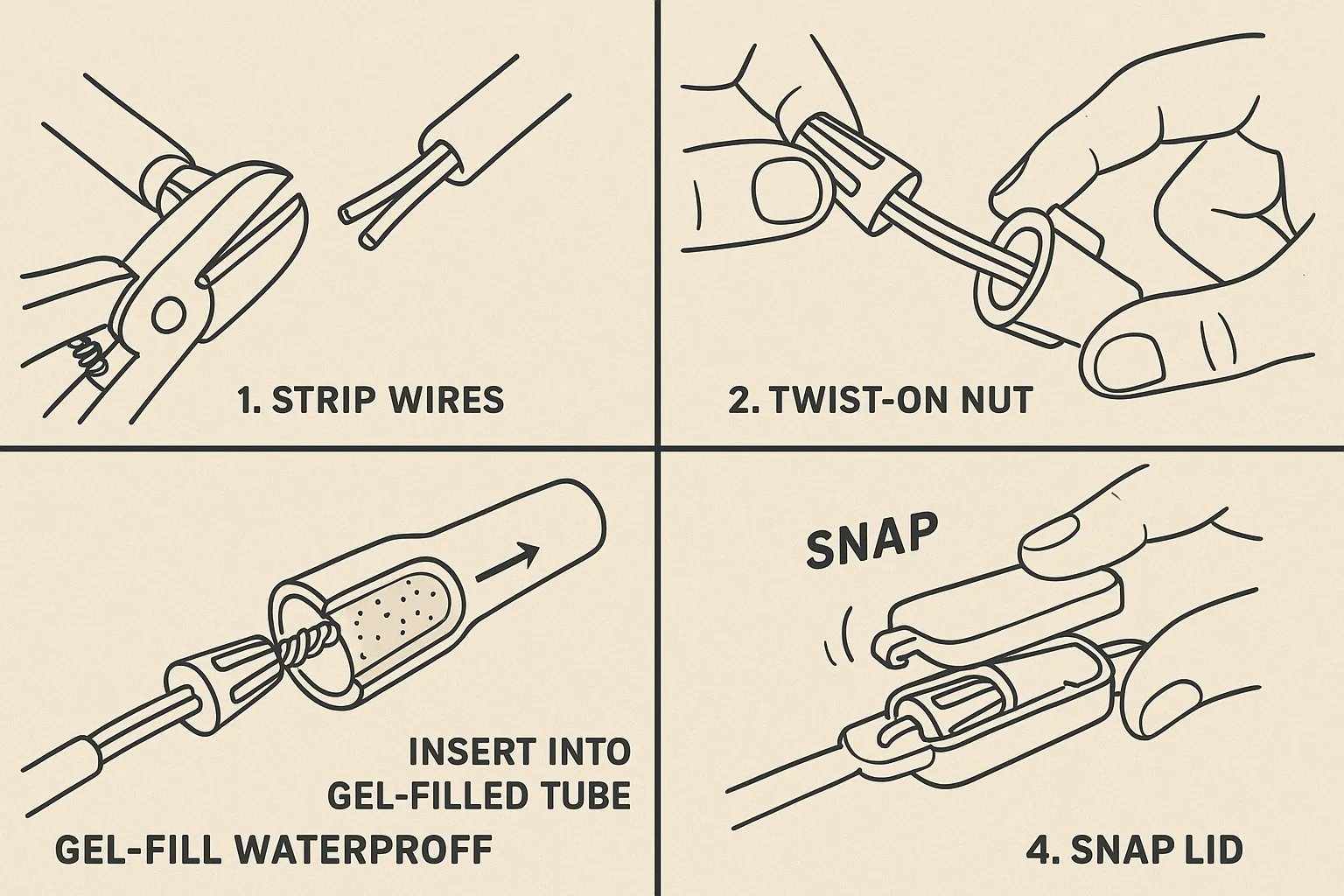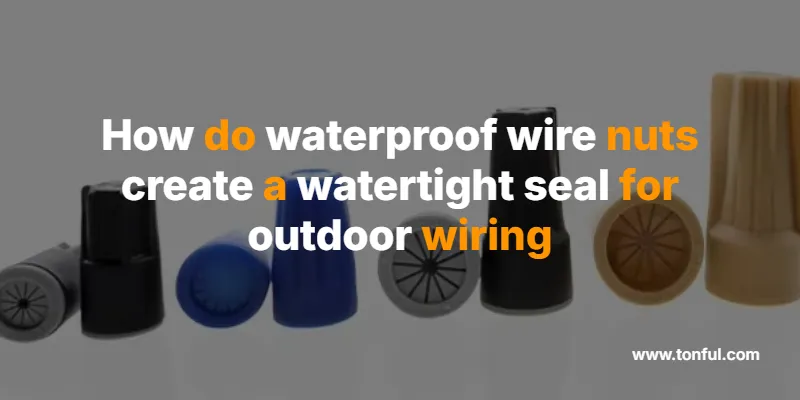Outdoor electrical splices face relentless assaults from rain, irrigation spray, condensation, insects and soil chemicals. Modern waterproof wire nuts withstand these hazards by combining three engineering features—a mechanical spring clamp, a hydrophobic sealant, and an enclosure that channels water away from the conductors. The result is a UL-486D–listed connection rated up to 600 V that can survive direct burial yet stay serviceable for decades.

Cutaway illustration of a silicone-filled waterproof wire nut, highlighting the spring, silicone sealant and protective shell
1. Mechanical Grip: The Live-Action Spring
A square-profile steel spring lines the interior of every twist-on connector. As you turn the cap clockwise, the spring’s leading edge cuts shallow threads into each conductor, then wedges harder with every twist. This “live-action” design compensates for:
- Temperature cycling that shrinks and expands copper
- Strand relaxation in fine-stranded landscape cable
- Vibration from lawn equipment
Because the spring bites through thin oxides, it also lowers contact resistance and heat rise.
2. Hydrophobic Barrier: Silicone or Gel Fill
Standard indoor wire nuts rely on trapped air to keep corrosion low. Outdoors, moisture inevitably enters. Waterproof versions pre-load the cap—or an external tube—with non-hardening, dielectric sealant:
- Silicone grease (IDEAL WeatherProof 63, DryConn Black/Gray). The paste surrounds the spring and keeps oxygen and water away from the copper.
- Gel (petroleum-based dielectric compound) used in direct-bury splice kits such as 3M DBR/Y-6 or Rain Bird DBRY20. After the twist is made, the entire nut is pressed into a polymer tube already brimmed with gel; snapping the lid forces excess compound up the wire jacket to eliminate voids.
Unlike two-part epoxies, these sealants stay pliable from −45 °F to 400 °F, allowing future re-entry and preventing stress on wire insulation.
3. Enclosure Geometry: Skirts, Tubes and Latches
The shell does more than insulate:
- Extended Skirt – funnels runoff away from the crimp and shields UV-sensitive sealant.
- Tapered Nose – clears tight valve boxes so wires bend gently.
- Latch-Cap Tubes – in gel kits, a lockable tube supplies strain relief and maintains IP68 depth ratings even if backfilled under sprinklers.

Installation steps for a gel-filled direct-bury splice kit
IP & UL Testing
To earn a UL 486D listing, assemblies undergo:
- 24-hour submersion, 6 cycles of freezing and oven bake, then megohmmeter leakage tests
- Sunlight resistance checks (Sun-Res), followed by salt-spray immersion for coastal service
Products that pass may be marketed “direct-bury” and “submersible” up to 30 V control wiring; higher voltages require placement inside a weatherproof box.
Installation Best Practices
| Step | Why it Matters | Pitfalls to Avoid |
|---|---|---|
| Strip correct length (½–¾ in.) | Ensures spring engages full copper area | Too short leaves bare copper in skirt; too long catches water |
| Hold wires even & twist nut until tight | Uniform contact pressure | Pre-twisting stranded wire can shear strands |
| Wipe excess sealant over skirt | Fills micro-channels along insulation | Leaving gaps invites capillary water entry |
| For gel tubes, push nut fully to bottom before latching | Forces air out; gel back-fills | Nuts left halfway create air pockets |
When to Choose Each Style
| Connector Family | Typical Use | Re-enterable? | Depth Rating |
|---|---|---|---|
| Silicone-filled twist-on (DryConn, IDEAL WeatherProof) | Above-grade boxes, fixture leads | Yes | Damp/wet, IP54 |
| Gel-tube direct-bury (3M DBR/Y-6, Rain Bird DBRY20) | Underground irrigation valves, decoder two-wire | Tube is one-time; nut reusable with new tube | IP68, 2 m submersion |
| Heat-shrink solder sleeve | Marine harnesses, trailer wiring | No | IP67 after shrink |
| O-ring circular plug (M12, Deutsch DT) | Detachable sensors, pumps | Yes | IP67-69K unmated/mated |
Why Not Ordinary Grease + Indoor Nut?
Generic plumber’s grease lacks dielectric purity and may out-gas acids; automotive dielectric grease alone offers no mechanical strain relief. UL demands the entire “sealing system” be tested together, because leakage often begins around the conductor entry, not through the compound itself.
Conclusion
Waterproof wire nuts succeed by pairing a time-proven spring connector with a permanent, flexible moisture block. The spring guarantees electrical integrity; the silicone or gel guarantees environmental integrity. Following the manufacturer’s strip length and insertion steps transforms a vulnerable outdoor splice into a maintenance-free, code-compliant joint.

